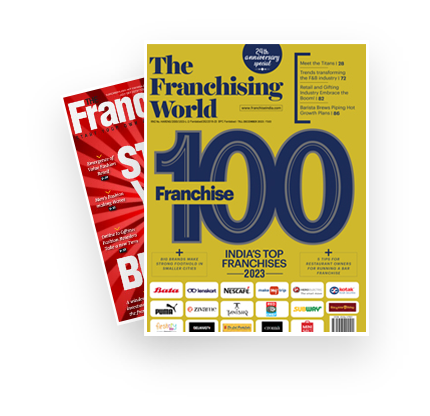
Franchising is a strategic method of expanding business by allowing others to operate under your brand using your established business model. In other words, Instead of personally opening every single location yourself and running them alongside, you grant the license to your brand and your way of doing business to those people who are highly motivated. In exchange, they pay you fees — usually an upfront franchise fee and continuing royalties.
You bring the blueprint, the support, the brand power; they bring the capital and the local execution.
How Franchising can Benefit you –
- Rapid growth without the expense and headache of constructing and operating each new store.
- More brand exposure at the same time in several different markets.
- An owner-operator network with skin in the game.
- Ongoing revenue channels through franchise fees, royalties and preferred vendor networks.
Is your business ready to be Franchised ?

Before jumping into the Franchise model, one must take a moment and assess whether your business is actually ready to be franchised or not. Franchising works best when –
- Your business is profitable and a known quantity: You have to show investors that success is repeatable. While systems and procedures are teachable, and should be well-documented and simple to follow, intuition isn’t. Your business is profitable and a known quantity: You have to show investors that success is repeatable. While systems and procedures are teachable, and should be well-documented and simple to follow, intuition isn’t.
- You have strong branding: Having a recognizable look and name makes it easier to attract both customers and franchisees.
- It’s scalable: Your idea is able to evolve into similar concepts in other markets or demographics.
How to create a Franchise Business plan (For Business owners)
-
Define your Vision
Begin by expressing your purpose and long-term vision for franchising. Whether your goal is to grow to 10 outlets in nearby communities or to create a chain of stores throughout the country, the clarity for the vision in this section will drive your strategic choices throughout the document.
2. Highlight your unique selling proposition (USP)
Your franchisees will want to understand what makes your business a wise investment. Find what has enabled your own business to succeed — whether it be efficiency, branding strength, or niche knowledge — and build that into a foundation for how others would come to represent your brand.
3. Explain the Franchise model
Explain how the relationship is transactional. This section explains what franchisees receive in return for their investment and how you both make money. Be clear and concise — it makes you sound prepared and professional.
4. Profile your ideal franchise
Not every applicant is right for us. Establishing the right expectations will also help you to ensure that franchisees will adhere to the values and processes at the core of your brand, providing a consistent experience for customers no matter which location they visit.
5. Detail Support and Training
A franchise is only as good as its support. Clear up what you will give to help each unit succeed, especially as they are getting off the ground.
Legal Considerations

- Franchise Disclosure Documents (FDDs)
The FDD is made for full disclosure, including everything important about the business model that you need to know, such as royalties, training programs and responsibilities for franchisees. This also establishes trust, which is a prerequisite. Provide some examples of how the best franchisors describe their FDD so that it connects with franchisees (i.e. a clear explanation of fees, a comprehensive overview of support, etcetera).
- Legal Agreements and contracts
Establish your franchise on a sure footing by creating clear contracts that specify territorial rights, use of intellectual property and operational standards. Anywhere applicable dispute resolution methods and terms for renewal/termination of contract should also be covered in the agreements.
- Regulatory Compliance
Keep up with local and international franchising regulations. Work with lawyers who can help you with the trade laws, tax codes, and advertising rules. Also think about the legal environment of developing nations, which includes intellectual property laws or tax breaks for small firms.
Establishing operational procedures
- Creating an Operating Manual
Create an operations manual that works as a detailed blueprint. You can even add more creative ways to it, for example, use technology to streamline your work. Include a brief on how to install energy save appliances or switch to digital inventory to save on waste and expenses.
- Franchisee Training Programs
Create interactive and immersive training. Leverage virtual reality simulations or gamified modules for an even more interactive and effective learning. Introduce real-world problem-solving scenarios that franchisees are likely to face, it will help them build confidence and competence.
- Implement a support system
Implementing a good support system like a dedicated Franchise portal featuring real-time analytics and peer-to-peer forums for collaborative problem-solving. You can even consider incorporating AI-powered chatbots for getting immediate answers to operational queries or troubleshooting issues.
Training and Support
-
Continuous Education Programs
Provide continuous education, e.g.: webinars, that will lead to a certificate, and interaction with leaders of the industry. This helps keep franchisees informed and competitive. Also, add special courses for various branches, like customer service, marketing, etc.
- Communication Channels Communication Channels
Promote an open dialogue using tools like Slack channels, specialized support hotlines and quarterly town hall meetings to increase collaboration. Improve communication with an app that offers updates, tips and franchise-wide announcements in real time.
- Performance Evaluation
Design metrics that are linked to business needs. Reel the best performing franchisees back in for motivation in the form of awards or incentives. Develop comparative dashboards for franchisees to measure their performance against their peers.
Franchisee Relations
-
Developing a Franchise Community
Create a sense of fellowship through retreats, virtual meetups or private online forums in which franchisees can discuss experiences and difficulties. Ways to accomplish include a yearly franchise summit that offers education, networking and celebrating.
- Resolving Disputes and Conflicts
Utilize an anticipatory method in dealing with conflicts and offer mediation services. Mainstay open communication to address issues promptly. Create a franchisee advisory council to represent common concerns and recommend solutions.
- Encouraging Feedback and Improvements
Encourage franchisees to brainstorm improvement ideas with us. Acknowledgment and implementation of suggestions will build a collegial and innovative spirit. Surveys and interviews should be conducted on a regular basis to assess the satisfaction of franchisees generally and identify areas for improvement.
Summing up
Franchising is the treasure vehicle through which one can get growth and success to a very high level. So, if you find yourself asking, "How do I franchise my business?", be ready for a tough but very rewarding journey ahead. One can turn one's vision into a powerful franchise network through close attention to detail, a scalable model and several innovative ways of developing relationships. The successful franchise is not merely a business: it's a community that flourishes-an institution built on collaboration and commitment in pursuit of shared entrepreneurial dreams.
SOME FREQUENTLY ASKED QUESTIONS
1. How to become a Franchise company?
To become a franchise company one needs the following: a business model that can be replicated, protection of its brand by law, franchising documentation, training of the franchisee, and a back-office support, marketing, and scalable systems building.
2. How much does it cost to franchise a business?
Costs vary but generally include legal fees, documents for F.D.D. development, manuals of operation, training programs, and marketing. Initial setup can range from a few hundred thousand to several crores, depending on the scale.
3. Can I franchise internationally?
Yes, however, it requires extra legal compliance, cultural adaptation, and international support systems. Many brands utilize master franchise or area development models for global expansion.
4. What are the risks of franchising?
Potential risks include:
- Loss of control over brand if systems aren’t followed
- Legal disputes with franchisees
- Difficulty maintaining quality standards across locations

